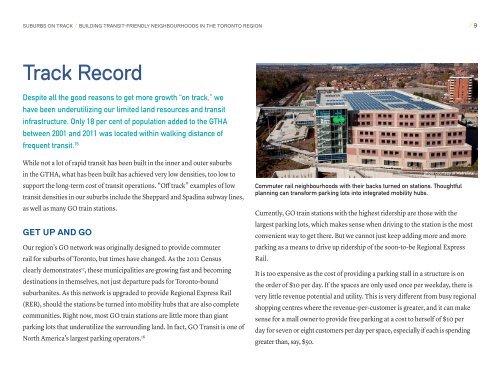SUBURBS ON TRACK
9oHn303Zgxi
9oHn303Zgxi
You also want an ePaper? Increase the reach of your titles
YUMPU automatically turns print PDFs into web optimized ePapers that Google loves.
<strong>SUBURBS</strong> <strong>ON</strong> <strong>TRACK</strong> / BUILDING TRANSIT-FRIENDLY NEIGHBOURHOODS IN THE TOR<strong>ON</strong>TO REGI<strong>ON</strong> / 9<br />
Track Record<br />
Despite all the good reasons to get more growth “on track,” we<br />
have been underutilizing our limited land resources and transit<br />
infrastructure. Only 18 per cent of population added to the GTHA<br />
between 2001 and 2011 was located within walking distance of<br />
frequent transit. 16<br />
While not a lot of rapid transit has been built in the inner and outer suburbs<br />
in the GTHA, what has been built has achieved very low densities, too low to<br />
support the long-term cost of transit operations. “Off track” examples of low<br />
transit densities in our suburbs include the Sheppard and Spadina subway lines,<br />
as well as many GO train stations.<br />
GET UP AND GO<br />
Our region’s GO network was originally designed to provide commuter<br />
rail for suburbs of Toronto, but times have changed. As the 2011 Census<br />
clearly demonstrates 17 , these municipalities are growing fast and becoming<br />
destinations in themselves, not just departure pads for Toronto-bound<br />
suburbanites. As this network is upgraded to provide Regional Express Rail<br />
(RER), should the stations be turned into mobility hubs that are also complete<br />
communities. Right now, most GO train stations are little more than giant<br />
parking lots that underutilize the surrounding land. In fact, GO Transit is one of<br />
North America’s largest parking operators. 18<br />
photo courtesy of Metrolinx<br />
Commuter rail neighbourhoods with their backs turned on stations. Thoughtful<br />
planning can transform parking lots into integrated mobility hubs.<br />
Currently, GO train stations with the highest ridership are those with the<br />
largest parking lots, which makes sense when driving to the station is the most<br />
convenient way to get there. But we cannot just keep adding more and more<br />
parking as a means to drive up ridership of the soon-to-be Regional Express<br />
Rail.<br />
It is too expensive as the cost of providing a parking stall in a structure is on<br />
the order of $10 per day. If the spaces are only used once per weekday, there is<br />
very little revenue potential and utility. This is very different from busy regional<br />
shopping centres where the revenue-per-customer is greater, and it can make<br />
sense for a mall owner to provide free parking at a cost to herself of $10 per<br />
day for seven or eight customers per day per space, especially if each is spending<br />
greater than, say, $50.


